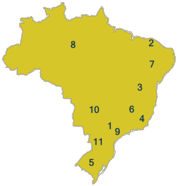Portuguese dialects
|
|
There are countries where the official languages are not understood by some (that uses a dialect, normally a subaltern language not recognized by the state as one), or they are dialects of the same language but others do not understand them. That is rare in Portuguese dialects, especially nowadays. A Portuguese speaker from Angola perfectly understands a speaker from northern Brazil or middle Portugal.
Portugal presents the wider variety of dialects in the Portuguese language. Although the country is very small, a city or village can have its own particular dialect. The Nortenho dialect in Portugal presents many regional words only used by them and the dialect (and neighbouring dialects) has (possibly) unique features not found in other Portuguese dialects. But because they are intelligible, even when using local words, Portuguese speakers do not understand what they speak as dialects, they use instead the word sotaque (accent) to describe it; some linguists agree and refer to them as falares (modes of speech).
In here, we will understand dialect has a regional variation of a language, with many differences due to geographical location: mainly lexicon and pronunciation. These differences are easily understood by the speakers, and thus identifying the origin region of the speaker is easy. Sometimes even cities or villages can be easily be identified by the dialect.
Varieties of Portuguese
A dialect can also be selected to be a variety of the language, due to prestige, culture or socio-economical factors. There are two officially used dialects in the Portuguese language. The one of Rio de Janeiro (and, in some manner, São Paulo) for Brazil and of Lisbon and Coimbra for Portugal, Portuguese speaking African countries and East Timor, due to politics the two varieties are somewhat written differently, but that difference is similar to what happens in English. These differences are to be eliminated because Brazil and Portugal have made an orthographic agreement. Because the African countries are involved and did not yet approved, it is not yet in force, thought Brazil has made some pressure, with the support of Portugal, in the African countries to approve the agreement.
Spoken varieties of Portuguese
- European and African Portuguese
- Brazilian Portuguese
- São Tomean Portuguese
- Galician Portuguese (considered by philologists)
note: In fact, Galician is a co-dialect of Portuguese. It has many differences not observed in other varieties due to Spanish influence. Considering it has a same language is very accepted (when not dealing with nationalisms), but not by political or sociologic factors.
Written varieties of Portuguese
- European and African Portuguese
- Brazilian Portuguese
Major Portuguese dialects
Brazil
- Caipira — Countryside of São Paulo - Piraquara — caipira from Vale do Paraíba (São Paulo (state) / Minas Gerais)
- Cearense — Ceará
- Baiano — Region of Bahia
-
 Fluminense (http://www.instituto-camoes.pt/cvc/hlp/geografia/som90.html) — States of Rio de Janeiro and Espírito Santo (the city of Rio de Janeiro has a particular way of speaking)
Fluminense (http://www.instituto-camoes.pt/cvc/hlp/geografia/som90.html) — States of Rio de Janeiro and Espírito Santo (the city of Rio de Janeiro has a particular way of speaking)
- Gaúcho — Rio Grande do Sul
- Mineiro — Minas Gerais
-
 Nordestino (http://www.instituto-camoes.pt/cvc/hlp/geografia/som91.html) — northeastern states of Brazil (the interior area and Recife have particular ways of speaking)
Nordestino (http://www.instituto-camoes.pt/cvc/hlp/geografia/som91.html) — northeastern states of Brazil (the interior area and Recife have particular ways of speaking)
- Nortista — Amazon Basin states
- Paulistano — city of São Paulo
- Sertanejo — States of Goiás and Mato Grosso
- Sulista — south of Brazil (the city of Curitiba has a particular way of speaking)
Portugueselanguagedialects-Portugal.png
Portugal
-
 Açoreano (http://www.instituto-camoes.pt/cvc/hlp/geografia/som69.html) — Azores
Açoreano (http://www.instituto-camoes.pt/cvc/hlp/geografia/som69.html) — Azores
-
 Alentejano (http://www.instituto-camoes.pt/cvc/hlp/geografia/som40.html) — Alentejo
Alentejano (http://www.instituto-camoes.pt/cvc/hlp/geografia/som40.html) — Alentejo
-
 Algarvio (http://www.instituto-camoes.pt/cvc/hlp/geografia/som44.html) — Algarve (there is a particular small dialect in the western area)
Algarvio (http://www.instituto-camoes.pt/cvc/hlp/geografia/som44.html) — Algarve (there is a particular small dialect in the western area)
-
 Alto-Minhoto (http://www.instituto-camoes.pt/cvc/hlp/geografia/som1.html) — North of Braga (interior)
Alto-Minhoto (http://www.instituto-camoes.pt/cvc/hlp/geografia/som1.html) — North of Braga (interior)
-
 Baixo-Beirão; Alto-Alentejano (http://www.instituto-camoes.pt/cvc/hlp/geografia/som49.html) — Central Portugal (interior)
Baixo-Beirão; Alto-Alentejano (http://www.instituto-camoes.pt/cvc/hlp/geografia/som49.html) — Central Portugal (interior)
-
 Beirão (http://www.instituto-camoes.pt/cvc/hlp/geografia/som9.html) — central Portugal
Beirão (http://www.instituto-camoes.pt/cvc/hlp/geografia/som9.html) — central Portugal
-
 Estremenho (http://www.instituto-camoes.pt/cvc/hlp/geografia/som22.html) — Regions of Coimbra and Lisbon (can be subdivided in Lisbon Portuguese and Coimbra Portuguese)
Estremenho (http://www.instituto-camoes.pt/cvc/hlp/geografia/som22.html) — Regions of Coimbra and Lisbon (can be subdivided in Lisbon Portuguese and Coimbra Portuguese)
-
 Madeirense (http://www.instituto-camoes.pt/cvc/hlp/geografia/som60.html) — Madeira
Madeirense (http://www.instituto-camoes.pt/cvc/hlp/geografia/som60.html) — Madeira
-
 Nortenho (http://www.instituto-camoes.pt/cvc/hlp/geografia/som14.html) — Regions of Braga and Porto
Nortenho (http://www.instituto-camoes.pt/cvc/hlp/geografia/som14.html) — Regions of Braga and Porto
-
 Transmontano (http://www.instituto-camoes.pt/cvc/hlp/geografia/som6.html) — Trás-os-Montes
Transmontano (http://www.instituto-camoes.pt/cvc/hlp/geografia/som6.html) — Trás-os-Montes
Angola
- Benguelense — Benguela province
-
 Luandense (http://www.instituto-camoes.pt/cvc/hlp/geografia/som85.html) — Luanda province
Luandense (http://www.instituto-camoes.pt/cvc/hlp/geografia/som85.html) — Luanda province
- Sulista — South of Angola
Portugueselanguagedialects-Angola.png
Other areas
-
 Caboverdiano (http://www.instituto-camoes.pt/cvc/hlp/geografia/som87.html) — Cape Verde
Caboverdiano (http://www.instituto-camoes.pt/cvc/hlp/geografia/som87.html) — Cape Verde
-
 Guineense (http://www.instituto-camoes.pt/cvc/hlp/geografia/som88.html) — Guinea-Bissau
Guineense (http://www.instituto-camoes.pt/cvc/hlp/geografia/som88.html) — Guinea-Bissau
-
 Macaense (http://www.instituto-camoes.pt/cvc/hlp/geografia/som92.html) — Macau, China
Macaense (http://www.instituto-camoes.pt/cvc/hlp/geografia/som92.html) — Macau, China
-
 Moçambicano (http://www.instituto-camoes.pt/cvc/hlp/geografia/som89.html) — Mozambique
Moçambicano (http://www.instituto-camoes.pt/cvc/hlp/geografia/som89.html) — Mozambique
-
 Santomense (http://www.instituto-camoes.pt/cvc/hlp/geografia/som83.html) — São Tomé and Principe
Santomense (http://www.instituto-camoes.pt/cvc/hlp/geografia/som83.html) — São Tomé and Principe
-
 Timorense (http://www.instituto-camoes.pt/cvc/hlp/geografia/som84.html) — East Timor
Timorense (http://www.instituto-camoes.pt/cvc/hlp/geografia/som84.html) — East Timor
- Damaense — Daman, India
- Goês — State of Goa, India

